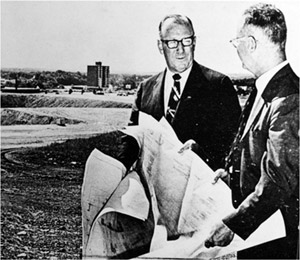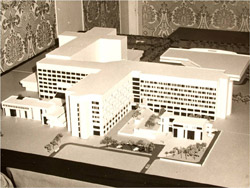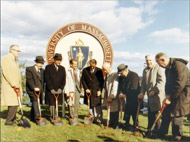How New England Tried to Increase the Number of Homegrown Medical Students-and Failed. Or, Why Massachusetts and Connecticut Built Their Own Schools
By Ellen More, PhD
Taken from the SoutteReview, Issue 32, the seasonal publication of the Lamar Soutter Library at the University of Massachusetts Medical School.
In 2008, UMass Med expanded the size of its entering class for the first time in decades, a response to a widespread call for more physicians, especially those dedicated to primary care. This was not the first time such a call was raised in Massachusetts or the nation. In the decade after World War II, in fact, the projected shortfall of physicians to care for an aging-and growing-population was a subject of intense concern to the federal government, the AMA, and the AAMC, as well as to average Americans unable to find a family doctor. In response to the perceived crisis in health "manpower," the New England states were empowered by Congress in 1956 to create the New England Board of Higher Education (NEBHE).
Its first task was to assess the region's production of physicians and dentists. To no one's surprise, the region was found wanting in the number of its young men and women who went to medical school. In the words of a Board report of 1957, "Fewer New England students study medicine in proportion to its population than students from the country as a whole ... Because we use more doctors than the national average ... we must import them in sizable numbers from the rest of the country." Yet, the Report continued, given the nation's future demand for physicians, "Certainly many more young men and women will be competing for admission to medical schools. However, those schools supported by state and municipal funds will logically feel that their first responsibility is to students from their own area..."
The NEBHE thus proposed that each New England state agree to spend $2500 for each local medical student who enrolled in one of the region's medical schools-public or private-beyond the number enrolled in 1956. For a moderate investment, the region might increase its medical graduates by the same number as if they had built a new school. Yet, when the Board examined the results of its plan three years later, despite the fact that every state but Connecticut had agreed to participate, the figures revealed a sorry story. The numbers had not improved. In fact, they had declined by 12.3%. Only the University of Vermont had kept its part of the bargain. Other New England schools, notably Harvard, Boston University, and Tufts, had actually reduced the number of students admitted from New England, recruiting instead from the increasing number of students applying from across the United States.
In the face of these results, the Board changed its tune. In 1959, it recommended: "That Massachusetts and Connecticut extend their programs of publicly supported higher education by establishing medical and dental schools." Within three months of this report, the AAMC received "serious" inquiries from both these states about creating a new medical school. From 1960, when the UMass system president J. W. Lederle took office, a campaign for a new, four-year, state-supported medical school began in earnest.
A Medical School For Massachusetts: Worcester and the Donahue Report of 1962
By Ellen More, PhD
Taken from the SoutteReview, Issue 33, the seasonal publication of the Lamar Soutter Library at the University of Massachusetts Medical School.
On May 31, 1961, the Democratic-controlled Massachusetts legislature authorized a "Recess Commission on the Establishment of a State-Supported Medical School." Massachusetts, in fact, had carried out such a study during the governorship of Paul Dever (1949-1953). That study recommended that a two-year school be established. The interests of private schools, such as Harvard, seemed to have squelched that idea.
Now, the stakes were considerably higher. Not only was the need for more doctors considered a national crisis, but the three Boston medical schools (Harvard, Boston University, and Tufts) had actually decreased their rates of acceptance of Massachusetts applicants. Worcester is usually seen as the surprise winner in a four-way race to host the school. Yet, a little-known straw vote by the members of the 1961 commission suggests that this may not have been true.

The Commission was chaired by Maurice Donahue, a Democrat, majority leader, and future president of the Senate. Among its fifteen members, only three had any direct connection to Worcester: the presidents of Assumption College and Clark University, and Massachusetts Representative Vite Pigaga, who had represented Worcester since 1958. Mr. Pigaga, whom I interviewed last year [2008], and whose papers in our collections have helped me document these events, firmly supported a state medical school and openly supported Worcester as the best site for it. He seemed greatly outnumbered—at first.
Donahue sought advice from leaders of the Association of American Medical Colleges (AAMC). But primarily he took the political pulse of Massachusetts citizens by holding a series of ten meetings covering most of the state. (Had he listened more closely to the AAMC, he would have heeded their advice to locate the new school on the main campus at Amherst.)

From the outset, Donahue and most of the Commission were convinced that the school should be located in a major urban center. They also clearly hoped to link it to an existing hospital, both to reduce the cost and the time of construction. Thus, the Commission closely inspected potential locations in Boston, Worcester, and Springfield. All three cities owned financially burdensome municipal hospitals they hoped to divest. In addition, state-owned Lemuel Shattuck Hospital in Boston seemed ripe for "re-purposing." (The fight to build a new teaching hospital will be chronicled in a future essay.)
The idea of a state medical school elicited a mixed response. According to both Donahue and Vite Pigaga, the Massachusetts Medical Society, the three Boston medical schools, and the Massachusetts Federation of Taxpayers' Associations all opposed the idea. Labor unions were strongly in favor, and didn't hesitate to say so from the beginning. In Worcester, supporters at first were cautious. But, by the fall of 1961, when word got out that the Commission would recommend a four-year, state medical school to be affiliated with the University of Massachusetts, Worcester came out strongly in favor of locating the school here.
In the end, the Donahue report recommended that the state establish a four-year school, that it be given fiscal independence as a guarantee of educational excellence, that the State commissioners of public health and mental health be made University Trustees, and that an appropriation be made for a dean and an architect. But they also recommended that the site decision be left in the hands of the University Trustees and the future medical school dean.

What the report did not disclose is that Donahue took a preliminary poll of the members' site preferences. As Vite Pigaga told me, Worcester won—by one vote. Only then did Donahue realize how contentious a question this would become, with members of the legislature likely to lobby for their own districts. In order to pass the enabling legislation for the school, the Commission's close vote for Worcester was withheld. The report was accepted on January 31, 1962. On July 27, 1962 the legislature enacted its proposals to establish a four-year state medical school as part of the University of Massachusetts. However, the fight over a location would occupy three additional years.
References:
- "Report of the Recess Commission on the Establishment of a State Supported Medical School," January, 31, 1962, pp. 1-35, Senate N. 627, [authorized] Under Chapter 122 of the Resolves of 1961. In Vita Pigaga Collection, UMass Archives.
- "The Medical School Issue," [Worcester] Evening Gazette, March 7, 1961, p. 6; "City Promoted as Site for State Medical College," Worcester Daily Telegram, November 10, 1961; "City's Bid for School is Readied," [Worcester] Evening Gazette, Dec. 8,1961
- Chap. 787 of the Acts of 1962, July 27, 1962.

